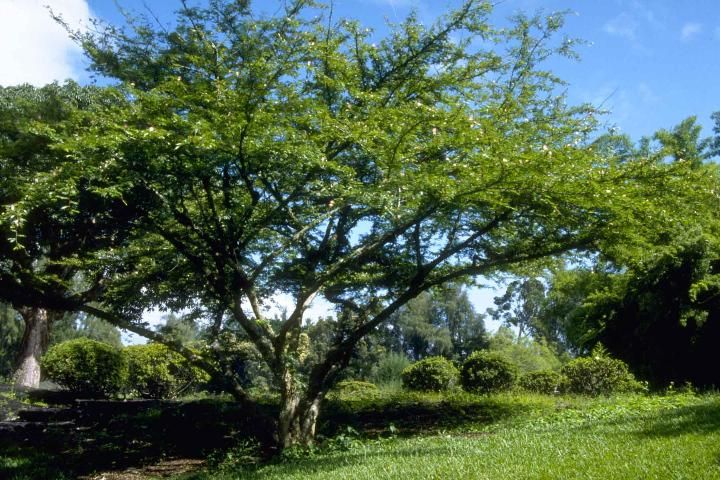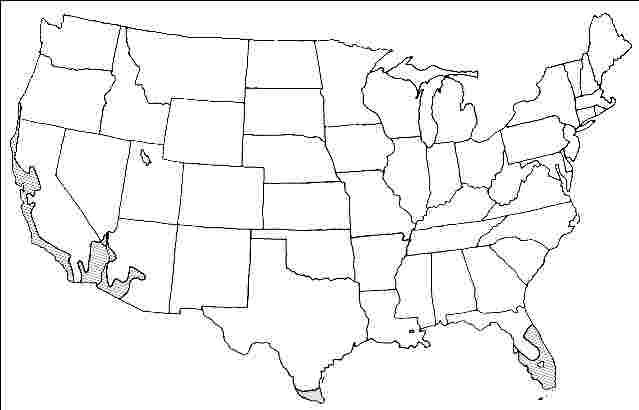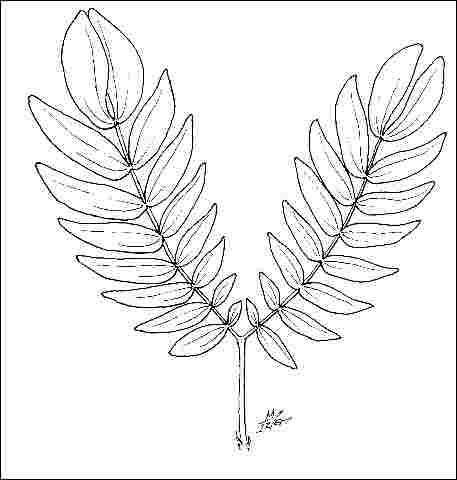Introduction
This large, multiple-trunked, low-branching, evergreen shrub has silky leaflets that are glossy copper when new, turning to a dark metallic green. The profuse, fragrant bloom is the main reason for its popularity, with big puffs, two to three inches across, of watermelon pink, deep red, or white silky stamens, produced during warm months.

Credit: Ed Gilman
General Information
Scientific name: Calliandra haematocephala
Pronunciation: kal-ee-AN-druh hee-mat-oh-SEFF-uh-luh
Common name(s): Powderpuff
Family: Leguminosae
USDA hardiness zones: 9B through 11 (Fig. 2)
Origin: not native to North America
Invasive potential: has been evaluated using the UF/IFAS Assessment of the Status of Non-Native Plants in Florida's Natural Areas (Fox et al. 2005). This species is not documented in any undisturbed natural areas in Florida. Thus, it is not considered a problem species and may be used in Florida.
Uses: hedge; specimen; deck or patio; container or planter; trained as a standard; espalier; highway median
Availability: not native to North America

Description
Height: 12 to 15 feet
Spread: 10 to 15 feet
Crown uniformity: irregular
Crown shape: vase, round
Crown density: open
Growth rate: fast
Texture: fine
Foliage
Leaf arrangement: alternate (Fig. 3)
Leaf type: bipinnately compound, even-pinnately compound
Leaf margin: entire
Leaf shape: oblong
Leaf venation: pinnate, parallel, bowed
Leaf type and persistence: evergreen
Leaf blade length: 2 to 4 inches, less than 2 inches
Leaf color: green
Fall color: no color change
Fall characteristic: not showy

Flower
Flower color: pink, red
Flower characteristics: showy
Fruit
Fruit shape: pod or pod-like
Fruit length: 3 to 6 inches
Fruit covering: dry or hard
Fruit color: brown
Fruit characteristics: does not attract wildlife; not showy; fruit/leaves not a litter problem
Trunk and Branches
Trunk/bark/branches: branches droop; not showy; typically multi-trunked; thorns
Pruning requirement: needed for strong structure
Breakage: resistant
Current year twig color: gray, green, brown
Current year twig thickness: thin, medium
Wood specific gravity: unknown
Culture
Light requirement: full sun, partial sun or partial shade
Soil tolerances: clay; sand; loam; slightly alkaline; acidic; well-drained
Drought tolerance: high
Aerosol salt tolerance: unknown
Other
Roots: not a problem
Winter interest: yes
Outstanding tree: no
Ozone sensitivity: unknown
Verticillium wilt susceptibility: unknown
Pest resistance: resistant to pests/diseases
Use and Management
With rapid growth in sandy soils and full sun, powderpuff bush will respond favorably to regular watering while young but should require no special care once established, except an occasional pruning to keep it within bounds. Powderpuff bush may be used as a tall (5- to 6-foot) flowering hedge and is often seen as a small, flowering specimen tree with the lower branches pruned off. Powderpuff can grow to about 15 feet tall when pruned into a small tree. The long, arching branches form an attractive canopy suitable for patio or container plantings. Pinching the new growth increases branch number and produces more flowers on a more compact plant.
Although plants are damaged by freezing temperatures, they grow back from the base in the spring in USDA hardiness zone 9.
Propagation is by seed or cuttings.
The cultivar 'White' has snow-white flowers.
Pests
While usually pest-free, powderpuff bush can be occasionally infested by mites, caterpillars, or other chewing insects.
Diseases
No diseases are of major concern.
Literature Cited
University of Florida, Institute of Food and Agricultural Sciences. 2018. "Assessment of Non-native Plants in Florida's Natural Areas" (https://assessment.ifas.ufl.edu, 4/29/2019) Gainesville, FL, 32611-4000, USA.